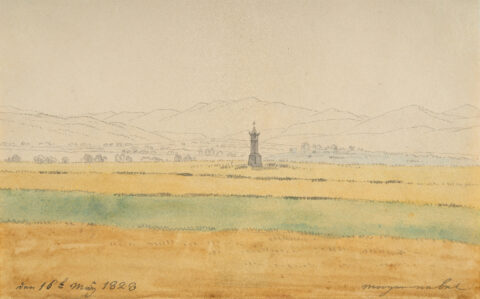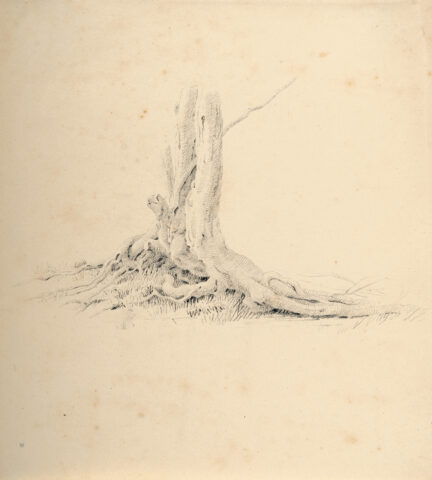
River landscape with a weir
Details
Börsch-Supan/Jähnig 18; Grummt 142.
Literatur:
Karl Scheffler, Erinnerung an Caspar David Friedrich, in: Kunst und Künstler, Heft 21, Berlin 1923, S. 99, mit Abb.;
Werner Sumowski, Caspar David Friedrich – Studien, Wiesbaden 1970, Kat.-Nr. 2, S. 158 und 182;
Helmut Börsch-Supan und Karl Wilhelm Jähnig, Caspar David Friedrich. Gemälde, Druckgraphik und bildmäßige Zeichnungen, München 1973, S. 241, Kat.-Nr. 18;
Christina Grummt, Caspar David Friedrich. Die Zeichnungen. Das gesamte Werk, München 2011, S. 164, Kat.-Nr. 142, mit Abb.
Provenienz:
Privatbesitz, Berlin, 1922;
Fritz Gurlitt, Berlin, 1923;
Sammlung Rüdiger von der Goltz, Berlin/Düsseldorf;
Lempertz, Köln, Auktion, 20.5.2017, Los 1505;
Privatsammlung, Sachsen.
Description
From the 1820s, from the height of his watercolour art, we look back to his early period, immediately after Friedrich came to Dresden from Copenhagen in 1798. The small sheet shows a tree landscape with a weir, which is special because it is one of the few drawings in Friedrich’s oeuvre to have a wild, rushing stream as a motif. Moving water is rare in his work – it mainly appears in his early works: In September 1798, Friedrich had drawn two views with waterfalls (Grummt 61 and 62) and in spring 1799 he showed a “Waterfall” at the Academy’s annual exhibition (Grummt 99): “Landscapes, in WaterColours. Quite good – especially the waterfall drawn with great boldness”, commented the critic Thomas Laye in the Allgemeine Literarische Anzeiger (no. 66, 29 April 1799, p. 651). The sheet exhibited in 1799 is considered lost today, but the description of the waterfall “as drawn with much boldness” also applies to our sheet. It is no longer possible to decide whether this is the sheet shown at the Academy – in any case, it gives an idea of what it might have looked like: In the foreground, the sheet shows a view of a stream bordered by timbers, which flows thunderously towards the viewer over two steps, while in the middle ground a row of larger and smaller deciduous trees stands at right angles to the pictorial space, offering a view of the meadows in the background at regular intervals. The scenery is loosely drawn with the brush, almost airily, and stylistically stands between the watercolours created in Copenhagen and the tree studies of the early Dresden years. The sheet still shows elements of traditional landscape depiction, in which the influence of Friedrich’s Dresden colleague Johann Philipp Veith, after whom Friedrich also copied in his early Dresden period, is noticeable.
The unusual format, in which the sides are bevelled in a trapezoidal shape, is almost unique and a very special feature in Friedrich’s drawings; it is only found once again on a sketchbook sheet showing the view from the Lilienstein to the table mountains on the other side of the Elbe (Staatliche Museen zu Berlin, Kupferstichkabinett, inv. no. SZ 52, cf. Grummt 111). This view is executed purely as a pen and ink drawing, but its conception is similarly pictorial, which is why Helmut Börsch-Supan has surmised that these could be designs for porcelain paintings.
Friedrich’s watercolours and sepias are, as it were, the essence of his art of drawing, in which he gave pictorial expression to his world of ideas – on a par with his paintings. – Minimally light-stained in the mat opening. The lower right corner slightly bumped and paper somewhat thinned there. In good condition.
* All results incl. buyer’s premium (27%) without VAT. No guarantee, subject to error.
** All post-auction prices excl. buyer's premium and VAT. No guarantee, subject to error.
*** Conditional Sale: The bid was accepted below the limit. Acquisition of the work may still be possible in our post-auction sale.
R = regular taxation
N = differential taxation on works of art which originate from a country outside of the EU
The private or commercial use of images shown on this Website, in particular through duplication or dissemination, is not permitted. All rights reserved.






